1.ECOSYSTEM
Components of Ecosystem:
Abiotic (non-living) components: It includes climatic factors (air, water, sunlight, rainfall, temperature and humidity), edaphic factors (soil air, soil water and pH of soil), topography (latitude, altitude), organic components (carbohydrates, proteins, lipids and humic substances) and inorganic substances (C, H, O, N and P). Abiotic components play vital role in any ecosystem and hence the total inorganic substances present in any ecosystem at a given time is called standing quality (or) standing state.
Biotic (living) components: It includes all living organisms like plants, animals, fungi and bacteria. They form the trophic structures of any ecosystem. On the basis of nutritional relationships, trophic levels of an ecosystem have two components.
Autotrophic components: Autotrophs are organisms which can manufacture the organic compounds from simple inorganic components through a process called photosynthesis. In most of the ecosystems, green plants are the autotrophs and are also called producers.
Heterotrophic components: Those organisms which consume the producers are called consumers and can be recognized into macro and micro consumers. Macroconsumers refer to herbivores, carnivores and omnivores (primary, secondary and tertiary consumers). Microconsumers are called decomposers. Decomposers are organisms that decompose the dead plants and animals to release organic and inorganic nutrients into the environment which are again reused by plants. Example: Bacteria, Actinomycetes and Fungi.
Functions of ecosystem:
Photosynthetically Active Radiation (PAR):
The amount of light available for photosynthesis of plants is called Photosynthetically Active Radiation (PAR) which is from 400-700 nm in wave length. It is essential for photosynthesis and plant growth. PAR is not always constant because of clouds, tree shades, air, dust particles, seasons, latitudes and length of the daylight availability. Generally plants absorb more blue and red light for efficient photosynthesis.
The total sunlight, 34 percent that reaches the atmosphere is reflected back into the atmosphere, moreover 10% is held by ozone, water vapours and atmospheric gases and the remaining 56% reaches the earth’s surface. Out of this 56%, only 2 – 10% of the solar energy is used by green plants for photosynthesis while the remaining portion is dissipated as heat.
PAR is generally expressed in millimoles / square meter / second by using silicon photo voltic detectors which detect only 400 – 700 nm wavelength of light. PAR values range from 0 to 3000 millimoles /square meter / second. At night PAR is zero and during midday in the summer, PAR often reaches 2000 – 3000 millimoles /square meter/second.
Productivity of an ecosystem:
The rate of biomass production per unit area in a unit time is called productivity. It can be expressed in terms of gm /m2/year or Kcal/m2/year.
Primary productivity:
The chemical energy or organic matter generated by autotrophs during the process of photosynthesis and chemosynthesis is called primary productivity. It is the source of energy for all organisms, from bacteria to human.
Gross Primary Productivity (GPP):
The total amount of food energy or organic matter or biomass produced in an ecosystem by autotrophs through the process of photosynthesis is called gross primary productivity
Net Primary Productivity (NPP):
The proportion of energy which remains after respiration loss in the plant is called net primary productivity. It is also called as apparent photosynthesis. Thus the difference between GPP and respiration is known as NPP.
NPP = GPP – Respiration
Secondary productivity:
The amount of energy stored in the tissues of heterotrophs or consumers is called secondary productivity.
Gross secondary productivity:
It is equivalent to the total amount of plant material ingested by the herbivores minus the materials lost as faeces.
Net secondary productivity:
Storage of energy or biomass by consumers per unit area per unit time, after respiratory loss is called net secondary productivity.
Community productivity:
The rate of net synthesis of organic matter (biomass) by a group of plants per unit area per unit time is known as community productivity.
Factors affecting primary productivity:
Primary productivity depends upon the plant species of an area, their photosynthetic capacity, availability of nutrients, solar radiation, precipitation, soil type, topographic factors (altitude, latitude, direction), and other environmental factors. It varies in different types of ecosystems.
Concept of trophic level in an ecosystem:
A trophic level refers to the position of an organism in the food chain. The number of trophic levels is equal to the number of steps in the food chain. The green plants (producers) occupying the first trophic level (T1) are called producers. The energy produced by the producers is utilized by the plant eaters (herbivores) they are called primary consumers and occupy the second trophic level (T2).
Herbivores are eaten by carnivores, which occupy the third trophic level (T3). They are also called secondary consumers or primary carnivores. Carnivores are eaten by the other carnivores, which occupy the fourth trophic level (T4). They are called the tertiary consumers or secondary carnivores. Some organisms which eat both plants and animals are called as omnivores (Crow). Such organisms may occupy more than one trophic level in the food chain.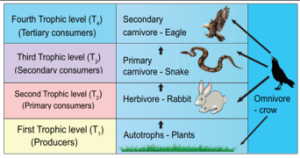
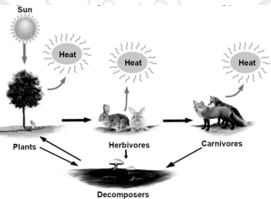
Energy flow:
The transfer of energy in an ecosystem between trophic levels can be termed as energy flow. It is the key function in an ecosystem. Part of the energy obtained from the sun by producers are transferred to consumers and decomposers through each trophic level, while some amount of energy is dissipated in the form of heat. Energy flow is always unidirectional in an ecosystem.
Laws of thermodynamics:
First law of thermodynamics:
It states that energy can be transmitted from one system to another in various forms. Energy cannot be destroyed or created. But it can be transformed from one form to another. As a result, the quantity of energy present in the universe is constant.
Example:
In photosynthesis, the product of starch (chemical energy) is formed by the combination of reactants (chlorophyll, H2O, CO2). The energy stored in starch is acquired from the external sources (light energy) and so there is no gain or loss in total energy. Here light energy is converted into chemical energy.
Second law of thermodynamics:
It states that energy transformation results in the reduction of the free energy of the system. Usually energy transformation cannot be 100% efficient. As energy is transferred from one organism to another in the form of food, a portion of it is stored as energy in living tissue, whereas a large part of energy is dissipated as heat through respiration. The transfer of energy is irreversible natural process. Example: Ten percent law
Ten percent law:
This law was proposed by Lindeman (1942). It states that during transfer of food energy from one trophic level to other, only about 10% stored at every level and rest of them (90%) is lost in respiration, decomposition and in the form of heat. Hence, the law is called ten percent law.
Example:
It is shown that of the 1000 Joules of Solar energy trapped by producers. 100 Joules of energy is stored as chemical energy through photosynthesis. The remaining 900 Joules would be lost in the environment. In the next trophic level herbivores, which feed on producers get only 10 Joules of energy and the remaining
90 Joules is lost in the environment. Likewise, in the next trophic level, carnivores, which eat herbivores store only 1 Joule of energy and the remaining 9 Joules is dissipated. Finally, the carnivores are eaten by tertiary consumers which store only 0.1 Joule of energy and the remaining 0.9 Joule is lost in the environment. Thus, at the successive trophic level, only ten percent energy is stored.
Food chain:
The movement of energy from producers upto top carnivores is known as food chain, i.e., in any food chain, energy flows from producers to primary consumers, then from primary consumers to secondary consumers, and finally secondary consumers to tertiary consumers. Hence, it shows linear network links. Generally, there are two types of food chain, (1) Grazing food chain and (2) Detritus food chain.
Grazing food chain:
Main source of energy for the grazing food chain is the Sun. It begins with the first link, producers (plants). The second link in the food chain is primary consumers (mouse) which get their food from producers. The third link in the food chain is secondary consumers (snake) which get their food from primary consumers. Fourth link in the food chain is tertiary consumers (eagle) which get their food from secondary consumers.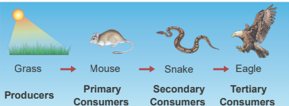
Detritus food chain:
This type of food chain begins with dead organic matter which is an important source of energy. A large amount of organic matter is derived from the dead plants, animals and their excreta. This type of food chain is present in all ecosystems.
The transfer of energy from the dead organic matter, is transferred through a series of organisms called detritus consumers (detritivores)- small carnivores – large (top) carnivores with repeated eating and being eaten respectively. This is called the detritus food chain.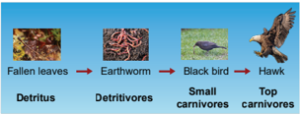
Food Web:
The inter-locking pattern of a number of food chain form a web like arrangement called food web. It is the basic unit of an ecosystem, to maintain its stability in nature. Which its also called homeostasis.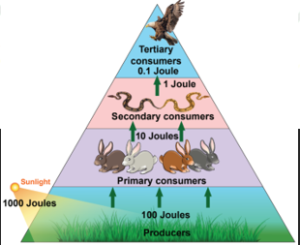
Example:
In a grazing food chain of a grass land, in the absence of a rabbit, a mouse may also eat food grains. The mouse in turn may be eaten directly by a hawk or by a snake and the snake may be directly eaten by hawks.
Hence, this interlocking pattern of food chains is the food web and the species of an ecosystem may remain balanced to each other by some sort of natural check.
Significance of food web:
- Food web is constructed to describe species interaction called direct interaction.
- It can be used to illustrate indirect interactions among different species.
- It can be used to study bottom-up or top-down control of community structure.
- It can be used to reveal different patterns of energy transfer in terrestrial and aquatic ecosystems.
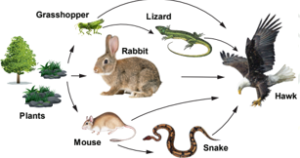
Ecological pyramids:
Graphic representation of the trophic structure and function at successive trophic levels of an ecosystem is called ecological pyramids.
Pyramid of number:
A graphical representation of the number of organisms present at each successive trophic level in an ecosystem is called pyramids of number. There are three different shapes of pyramids upright, spindle and inverted.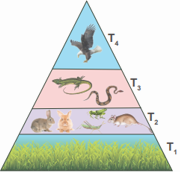
Spindle Shaped Pyramid:
There is a gradual decrease in the number of organisms in each trophic level from producers to primary consumers and then to secondary consumers, and finally to tertiary consumers. Therefore, pyramids of number in grassland and pond ecosystem are always upright.
In a forest ecosystem the pyramid of number is somewhat different in shape, it is because the base (T1) of the pyramid occupies large sized trees (Producer) which are lesser in number. Herbivores (T2) (Fruit eating birds, elephant, deer) occupying second trophic level, are more in number than the producers. In final trophic level (T4), tertiary consumers (lion) are lesser in number than the secondary consumer (T3) (fox and snake). Therefore, the pyramid of number in forest ecosystem looks spindle shaped.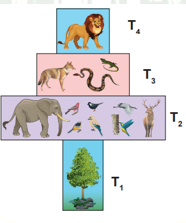
Inverted pyramid:
The pyramid of number in a parasite ecosystem is always inverted, because it starts with a single tree. Therefore there is gradual increase in the number of organisms in successive tropic levels from producer to tertiary consumers.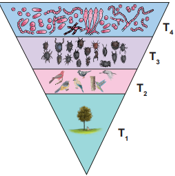
Pyramid of biomass:
A graphical representation of the amount of organic material (biomass) present at each successive trophic level in an ecosystem is called pyramid of biomass.
In grassland and forest ecosystems, there is a gradual decrease in biomass of organisms at successive trophic levels from producers to top carnivores (Tertiary consumer). Therefore, these two ecosystems show pyramids as upright pyramids of biomass.
However, in pond ecosystem, the bottom of the pyramid is occupied by the producers, which comprise very small organisms possessing the least biomass and so, the value gradually increases towards the tip of the pyramid. Therefore, the pyramid of biomass is always inverted in shape.
Pyramid of energy:
A graphical representation of energy flow at each successive trophic level in an ecosystem is called pyramid of energy. The bottom of the pyramid of energy is occupied by the producers. There is a gradual decrease in energy transfer at successive tropic levels from producers to the upper levels. Therefore, the pyramid of energy is always upright.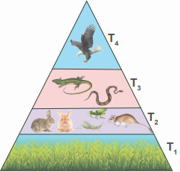
Decomposition:
Decomposition is a process in which the detritus (dead plants, animals and their excreta) are broken down in to simple organic matter by the decomposers. It is an essential process for recycling and balancing the nutrient pool in an ecosystem.
Mechanism of decomposition
Fragmentation – The breaking down of detritus into smaller particles by detritivores like bacteria, fungi and earth worm is known as fragmentation. These detritivores secrete certain substances to enhance the fragmentation process and increase the surface area of detritus particles.
Catabolism – The decomposers produce some extracellular enzymes in their surroundings to break down complex organic and inorganic compounds in to simpler ones. This is called catabolism
Leaching or Eluviation – The movement of decomposed, water soluble organic and inorganic compounds from the surface to the lower layer of soil or the carrying away of the same by water is called leaching or eluviation.
Humification – It is a process by which simplified detritus is changed into dark coloured amorphous substance called humus. It is highly resistant to microbial action, therefore decomposition is very slow. It is the reservoir of nutrients.
Mineralisation – Some microbes are involved in the release of inorganic nutrients from the humus of the soil, such process is called mineralisation.
Factors affecting decomposition:
Decomposition is affected by climatic factors like temperature, soil moisture, soil pH, oxygen and also the chemical quality of detritus.
Biogeochemical cycles:
All organisms require nutrients for their growth, development, maintenance and reproduction. Circulation of nutrients within the ecosystem or biosphere is known as biogeochemical cycles and also called as ‘cycling of materials.’ There are two basic types,
Gaseous cycle – It includes atmospheric Oxygen, Carbon and Nitrogen cycles.
Sedimentary cycle – It includes the cycles of Phosphorus, Sulphur and Calcium – Which are present as sediments of earth.
Carbon cycle:
The circulation of carbon between organisms and environment is known as the carbon cycle. Carbon is an inevitable part of all biomolecules and is substantially impacted by the change in global climate. Cycling of carbon between organisms and atmosphere is a consequence of two reciprocal processes of photosynthesis and respiration. The releasing of carbon in the atmosphere increases due to burning of fossile fuels, deforestration, forest fire, volcanic eruption and decomposition of dead organic matters.
Phosphorus cycle:
It is a type of sedimentary cycle. Already we know that phosphorus is found in the biomolecules like DNA, RNA, ATP, NADP and phospholipid molecules of living organisms. Phosphorus is not abundant in the biosphere, whereas a bulk quantity of phosphorus is present in rock deposits, marine sediments and guano. It is released from these deposits by weathering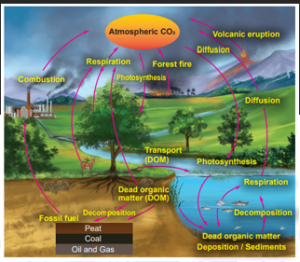
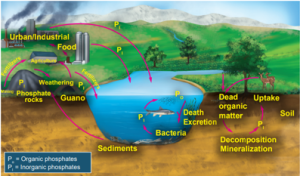
Types of ecosystem: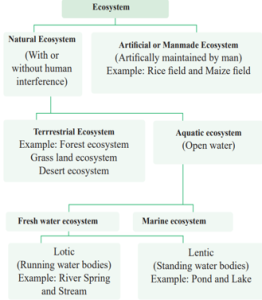
Structure of Pond ecosystem:
It is a classical example for natural, aquatic, freshwater, lentic type of ecosystem. It helps us to understand the structure and function of an ecosystem. When rain water gathers in a shallow area, gradually over a period of time, different kinds of organisms (microbes, plants, animals) become part of this ecosystem. This pond ecosystem is a self sustaining and self regulatory fresh water ecosystem, which shows a complex interaction between the abiotic and biotic components in it.
Abiotic components:
A pond ecosystem consists of dissolved inorganic (CO2, O2, Ca, N, Phosphate) and organic substances (amino acids and humic acid) formed from the dead organic matter. The function of pond ecosystem is regulated by few factors like the amount of light, temperature, pH value of water and other climatic conditions.
Biotic components:
They constitute the producers, variety of consumers and decomposers (microorganisms).
Producers:
A variety of phytoplanktons like Oscillatoria, Anabaena, Chlamydomonas, Pandorina Eudorina, Volvox and Diatoms. Filamentous algae such as Ulothrix, Spirogyra, Cladophora and Oedogonium; floating plants Azolla, Salvia, Pistia, Wolffia and Eichhornia; sub-merged plants Potamogeton and Phragmitis; rooted floating plants Nymphaea and Nelumbo; macrophytes like Typha and Ipomoea, constitute the major producers of a pond ecosystem.
Consumers:
The animals represent the consumers of a pond ecosystem which include zooplanktons like Paramoecium and Daphnia (primary consumers); benthos (bottom living animals) like mollusces and annelids; secondary consumers like water beetles and frogs; and tertiary consumers (carnivores) like duck , crane and some top carnivores which include large fish, hawk ,man, etc.
Decomposers:
They are also called as microconsumers. They help to recycle the nutrients in the ecosystem. These are present in mud water and bottom of the ponds. Example: Bacteria and Fungi. Decomposers perform the process of decomposition in order to enrich the nutrients in the pond ecosystem.
Stratification of pond ecosystem:
Based on the factors like distance from the shore, penetration of light, depth of water, types of plants and animals, there may be three zones, littoral, limnetic and profundal. The littoral zone, which is closest to the shore with shallow water region, allows easy penetration of light. It is warm and occupied by rooted plant species. The limnetic zone refers the open water of the pond with an effective penetration of light and domination of planktons. The deeper region of a pond below the limnetic zone is called profundal zone with no effective light penetration and predominance of heterotrophs. The bottom zone of a pond is termed benthic and is occupied by a community of organisms called benthos (usually decomposers).The primary productivity through photosynthesis of littoral and limnetic zone is more due to greater penetration of light than the profundal zone.
Ecosystem services (Benefits):
Provisoning services:
- Food, fiber and fuel
- Genetic resources
- Bio-chemicals
- Fresh water
- Medicines
Cultural services:
- Spiritual and religious values
- Knowledge system
- Education and inspiration
- Recreation and aesthetic values
- Ecotourism
Supporting services:
- Primary production
- Provision of habitat
- Nutrient cycling
- Soil formation and retention
- Production of atmospheric oxygen
- Water cycling
Regulating services:
- Invasion resistance
- Herbivory pollination
- Seed dispersal
- Climate regulation
- Pest regulation
- Disease regulation
- Erosion regulation
- Water purification
- Natural hazard protection
Anthropogenic activities affect ecosystem services:
- Habitat destruction
- Deforestation and over grazing
- Erosion of soils
- Introduction of non-native species
- Over harvesting of plant material
- Pollution of land, water and air
- Run off pesticides, fertilizers and animal wastes
Mangrove ecosystem services:
- Offers habitat and act as nursery for aquatic plants and animals
- Provides medicine, fuel wood and timber.
- Act as bridge between sea and rivers by balancing sedimentation and soil erosion.
- Help to reduce water force during cyclones, tsunamis and high tide periods.
- Help in wind break, O2 production, carbon sequestration and prevents salt spray from waves.
“If we fail to protect environment, we will fail to save posterity”.
- Buy and use only ecofriendly products and recycle them.
- Grow more trees
- Choose sustained farm products (vegetables, fruits, greens, etc.)
- Reduce the use of natural resources.
- Recycle the waste and reduce the amount of waste you produce.
- Reduce consumption of water and electricity.
- Reduce or eliminate the use of house-hold chemicals and pesticides.
- Maintain your cars and vehicles properly. (In order to reduce carbon emission)
- Create awareness and educate about ecosystem protection among your friends and family members and ask them to find out solution to minimise this problem.
Ecosystem Management:
- It is used to maintain biodiversity of ecosystems.
- It helps in indicating the damaged ecosystem (Some species indicate the health of the ecosystem: such species are called a flagship species).
- It is used to recognize the inevitability of ecosystem change and plan accordingly.
- It is one of the tools used for achieving sustainability of ecosystem through sustainable development programme (or projects).
- It is also helpful in identifying ecosystems which are in need of rehabilitation.
- It involves collaborative management with government agencies, local population, communities and NGO’s.
- It is used to build the capacity of local institutions and community groups to assume responsibility for long term implementation of ecosystem management activities even after the completion of the project.
Plant Succession:
We very often see that forests and lands in our areas are drastically affected by natural calamities (Flood, earthquake) and anthropogenic activities (Fire, over grazing, cutting of trees). Due to these reasons all plants of an area are destroyed and the areas become nude. When we observe this area, over a period of a time we can see that it will be gradually covered by plant community again and become fertile. Such successive replacement of one type of plant community by the other of the same area/ place is known as plant succession. The first invaded plants in a barren area are called pioneers. On the other hand, a series of transitional developments of plant communities one after another in a given area are called seral communities. At the end a final stage and a final plant community gets established which are called as climax and climax community respectively.
Causes of Succession:
Ever since the onset of origin of life, organic evolution and ecological succession are taking place parallelly. Ecological succession is a complex process. There are three types of causes for any ecological succession.
Initiating causes – Activity of abiotic (light, temperature, water, fire, soil erosion and wind) and biotic factors (competition among organisms) leads to formation of a barren area or destruction of the existing community of an area, initiating primary or secondary succession respectively.
Continuing causes – The processes of migration, aggregation, competition, reaction etc, are the continuing causes which lead to change the plant communities and nature of the soil in an area.
Stabilizing causes – The stabilization of the plant community in an area is primarly controlled by climatic factors rather than other factors.
Characteristics of ecological succession:
- It is a systematic process which causes changes in specific structure of plant community.
- It is resultant of changes of abiotic and biotic factors.
- It transforms unstable community into a stable community.
- Gradual progression in species diversity, total biomass, niche specialisation, and humus content of soil takes place.
- It progresses from simple food chain to complex food web.
- It modifies the lower and simple life form to the higher life forms.
- It creates inter-dependence of plants and animals.
Types of succession:
The various types of succession have been classified in different ways on the basis of different aspects.
Primary succession – The development of plant community in a barren area where no community existed before is called primary succession. The plants which colonize first in a barren area is called pioneer species or primary community or primary colonies. Generally, Primary succession takes a very long time for the occurrence in any region.
Example: Microbes, Lichen, Mosses.
Secondary succession – The development of a plant community in an area where an already developed community has been destroyed by some natural disturbance (Fire, flood, human activity) is known as secondary succession. Generally, this succession takes less time than the time taken for primary succession.
Example:
The forest destroyed by fire and excessive lumbering may be re-occupied by herbs over a period of time.
Allogenic succession:
Allogeneic succession occurs as a result of abiotic factors. The replacement of existing community is caused by other external factors (soil erosion, leaching, etc.,) and not by existing organisms.
Example: In a forest ecosystem soil erosion and leaching alter the nutrient value of the soil leading to the change of vegetation in that area.
Autotrophic succession:
If the autotrophic organisms like green plants are dominant during the early stages of succession it is called autotrophic succession, this occurs in the habitat which is rich in inorganic substances. Since, green plants dominate in the beginning of this succession, there is a gradual increase in organic matter and subsequently the energy flow in the ecosystem.
Process of succession:
Nudation – This is the development of a barren area without any form of life. The barren area may be developed due to topographic (soil erosion, wind action), climatic (hails, storm, fire), and biotic (human activities, epidemics, etc.,) factors.

Invasion – If species invade or reach a barren area from any other area it is called invasion. When the seeds, spores or other propagules of plant species reach the barren area, by air, water and various other agent, it is known as migration.
Ecesis (Establishment) – After reaching a new area (invasion), the successful establishment of the species, as a result of adjustment with the conditions prevailing in the area, is known as ecesis. If the establishment is complete, the plant will be able to reproduce sexually in that particular area.
Aggregation – The successful establishment of species, as a result of reproduction and increase in population of the species than the earlier stage is called aggregation.
Competition – It refers to the aggregation of a particular species in an area which leads to inter specific and intraspecific competition among the individuals for water, nutrient, radiant energy, CO2, O2 and space, etc.
Reaction – The species occupying a habitat gradually modify the environmental condition, where the existing species community is displaced or replaced by another. This is called reaction. The community which is replaced by another community is called seral community.
Stabilization (Climax stage) – The final establishment of plant community is called stabilization. This establishment of a plant community which maintains itself in equilibrium with climax of the area and not replaced by others is known as climax community and the stage is climax stage.
Hydrosere:
The succession in a freshwater ecosystem is also referred to as hydrosere. Succession in a pond, begins with colonization of the pioneers like phytoplankton and finally ends with the formation of climax community like forest stage.
Phytoplankton stage – It is the first stage of succession consisting of the pioneer community like blue green algae, green algae, diatoms, bacteria, etc., The colonization of these organisms enrich the amount of organic matter and nutrients of pond due to their life activities and death. This favors the development of the next seral stages.
Submerged plant stage – As the result of death and decomposition of planktons, silt brought from land by rain water, lead to a loose mud formation at the bottom of the pond. Hence, the rooted submerged hydrophytes begin to appear on the new substratum. Example: Chara, Utricularia, Vallisneria and Hydrilla etc. The death and decay of these plants will build up the substratum of pond to become shallow. Therefore, this habitat now replaces another group of plants which are of floating type.
Submerged free floating stage – During this stage, the depth of the pond will become almost 2-5 feet. Hence, the rooted hydrophytic plants and with floating large leaves start colonising the pond. Example: Rooted floating plants like Nelumbo, Nymphaea and Trapa.Some free floating species like Azolla, Lemna, Wolffia and Pistia are also present in this stage. By death and decomposition of these plants, further the pond becomes shallower. Due to this reason, floating plant species is gradually replaced by another species which makes new seral stage.
Reed-swamp stage – It is also called an amphibious stage. During this stage, rooted floating plants are replaced by plants which can live successfully in aquatic as well as aerial environment. Example: Typha, Phragmites, Sagittaria and Scirpus etc. At the end of this stage, water level is very much reduced, making it unsuitable for the continuous growth of amphibious plants.
Marsh meadow stage – When the pond becomes swallowed due to decreasing water level, species of Cyperaceae and Poaceae such as Carex, Juncus, Cyperus and Eleocharis colonise the area. They form a mat-like vegetation with the help of their much branched root system. This leads to an absorption and loss of large quantity of water. At the end of this stage, the soil becomes dry and the marshy vegetation disappears gradually and leads to shurb stage.
Shrub stage – As the disappearance of marshy vegetation continues, soil becomes dry. Hence, these areas are now invaded by terrestrial plants like shrubs (Salix and Cornus) and trees (Populus and Alnus). These plants absorb large quantity of water and make the habitat dry. Further, the accumulation of humus with a rich flora of microorganisms produce minerals in the soil, ultimately favouring the arrival of new tree species in the area.
Forest stage – It is the climax community of hydrosere. A variety of trees invade the area and develop any one of the diverse type of vegetation. Example: Temperate mixed forest (Ulmus, Acer and Quercus), Tropical rain forest (Artocarpus and Cinnamomum) and Tropical deciduous forest (Bamboo and Tectona).
Lithosere:
Lithosere is a type of xerosere initiating on a barren rock surface. The barren rock is devoid of water and organic matter. A barren rock surface gets mineral deposits due to weathering. This results in the colonization of pioneer organisms like crustose lichens. Through a series of successive seral stages, forest stage (Climax community) is achieved finally.
Crustose lichen stage – The pioneers like crustose lichens (Rhizocarpon and Lecanora) secrete some acids which enhance the weathering of rock. Due to this continuous process, small particles of rocks are formed, which together with decaying lichen make the first thin layer of soil on rock surface. However, this process is very slow. At the end, this habitats become less fit for existing plants and is gradually replaced by another type of lichens called foliose lichen.
Foliose lichen stage – Gradually crustose lichens are replaced by foliose lichen like Parmelia and Dermatocarpon etc. These plants have leaf like structures. They also secrete some acids which further loosen the rocks into small soil particles. This process enhances water retaining capacity of the habitat and causes further accumulation of soil particles and humus. Gradual changes make the area less favourable for existing foliose lichen.
Moss stage – When the habitat is changed, the existing foliose lichen starts disappearing and favours the growth of some xerophytic moss like Polytrichum, Tortula and Grimmia. The luxurious growth of moss competes with lichens. Due to the death and decay of mosses, further addition of humus and moisture to the habitat takes place. Therefore, the next seral community tries to replace the moss community.
Herb stage – With the gradual disappearance of moss stage, herbaceous plant communities like Aristida, Festuca and Poa, etc., invade the habitat. The extensive growth of these herbs alter the habitat. The decaying leaves, stems, root and other parts of these plants get deposited on the soil surface in the form of humus. It further increases the water holding capacity of soil. These conditions become more suitable for shrubs.
Shrub stage – The habitat change results in the invasion of shrubs like Rhus, Zizyphus, Capparis and dominated by herbaceous plants. The death and decaying of shrubs further enrich the habitat with soil and humus. Therefore, the shrubs are replaced by trees which constitute the climax community.
Forest stage – The trees capable of growing in xerophytic condition try to invade the area which was occupied previously by shrubs. Further increasing the humus content of the soil favours the arrival of more trees and vegetation finally become mesophytes. As the trees are deeply rooted and much branched, they absorb more quantity of water and nutrients. After a long interval, a complete harmony is established among the plant communities. The climax stage remains unchanged unless some major environmental changes disturb it.
Significance of Plant Succession:
- Succession is a dynamic process. Hence an ecologist can access and study the seral stages of a plant community found in a particular area.
- The knowledge of ecological succession helps to understand the controlled growth of one or more species in a forest.
- Utilizing the knowledge of succession, even dams can be protected by preventing siltation.
- It gives information about the techniques to be used during reforestation and afforestation.
- It helps in the maintenance of pastures.
- Plant succession helps to maintain species diversity in an ecosystem.
- Patterns of diversity during succession are influenced by resource availability and disturbance by various factors.
- Primary succession involves the colonization of habitat of an area devoid of life.
- Secondary succession involves the reestablishment of a plant community in disturbed area or habitat.
- Forests and vegetation that we come across all over the world are the result of plant succession.
Go green:
- Close the tap when not in use.
- Switch off the electrical gadgets when not in use.
- Never use plastics and replace them with biodegradable products
- Always use ecofriendly technology and products.
Ecosystem resilience:
Ecosystem is damaged by disturbances from fire, flood, predation, infection, drought, etc., removing a great amount of biomasss. However, ecosystem is endowed with the ability to resist the damage and recover quickly. This ability of ecosystem is called ecosystem resilience or ecosystem robustness.
Blue carbon ecosystems:
Sea grasses and mangroves of Estuarine and coastal ecosystems are the most efficient in carbon sequestration. Hence, these ecosystems are called as “Blue carbon ecosystems”. They are not properly utilized and maintained all over the world although they have rich bioresources potential.
Types of Carbon:
- Green carbon – carbon stored in the biosphere (by the process of photosynthesis).
- Grey carbon – carbon stored in fossil fuel (coal, oil and biogas deposits in the lithosphere).
- Blue carbon – carbon stored in the atmosphere and oceans.
- Brown carbon – carbon stored in industrialized forests (wood used in making commercial articles)
Black carbon – carbon emitted from gas, diesel engine and coal fired power Plants.
